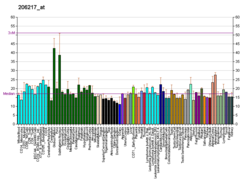Top Qs
Timeline
Chat
Perspective
Ectodysplasin A
Protein-coding gene in humans From Wikipedia, the free encyclopedia
Remove ads
Ectodysplasin A (EDA) is a protein that in humans is encoded by the EDA gene.
Ectodysplasin A is a transmembrane protein of the TNF family which plays an important role in the development of ectodermal tissues such as skin in humans.[5][6] It is recognized by the ectodysplasin A receptor.
Remove ads
Function
The protein encoded by this gene is a type II membrane protein that can be cleaved by furin to produce a secreted form. The encoded protein, which belongs to the tumor necrosis factor family, acts as a homotrimer and may be involved in cell-cell signaling during the development of ectodermal organs. Along with c-Met, it has been shown to be involved in the differentiation of anatomical placodes, precursors of scales, feathers and hair follicles in vertebrates.[7] Defects in this gene are a cause of ectodermal dysplasia, anhidrotic, which is also known as X-linked hypohidrotic ectodermal dysplasia. Several transcript variants encoding many different isoforms have been found for this gene.[6] At least 61 disease-causing mutations in this gene have been discovered.[8]
Remove ads
References
Further reading
External links
Wikiwand - on
Seamless Wikipedia browsing. On steroids.
Remove ads






